

In this blog post, I would like to give you a high level overview of the OAuth 2 specification. When I started to learn about this, I got lost very quickly in all the different aspects that are involved. To make sure you don’t have to go through the same thing, I’ll explain OAuth 2 as if you don’t even have a technical background. Since there is a lot to cover, let’s jump right in!
The core concepts of security
When it comes to securing an application, there are 2 core concepts to keep in mind: authentication and authorization.
Authentication
With authentication, you’re trying to answer the question “Who is somebody?” or “Who is this user?” You have to look at it from the perspective of your application or your server. They basically have stranger danger. They don’t know who you are and there is no way for them to know that unless you prove your identity to them. So, authentication is the process of proving to the application that you are who you claim to be.
In a real world example, this would be providing your ID or passport to the police when they pull you over to identify yourself. Authentication is not part of the standard OAuth 2 specification. However, there is an extension to the specification called Open ID Connect that handles this topic.
Authorization
Authorization is the flip side of authentication. Once a user has proven who they are, the application needs to figure out what a user is allowed to do. That’s essentially what the authorization process does.
An easy way to think about this is the following example. If you are a teacher at a school, you can access information about the students in your class. However, if you are the principal of the school you probably have access to the records of all the students in the school. You have a larger access because of your job title.
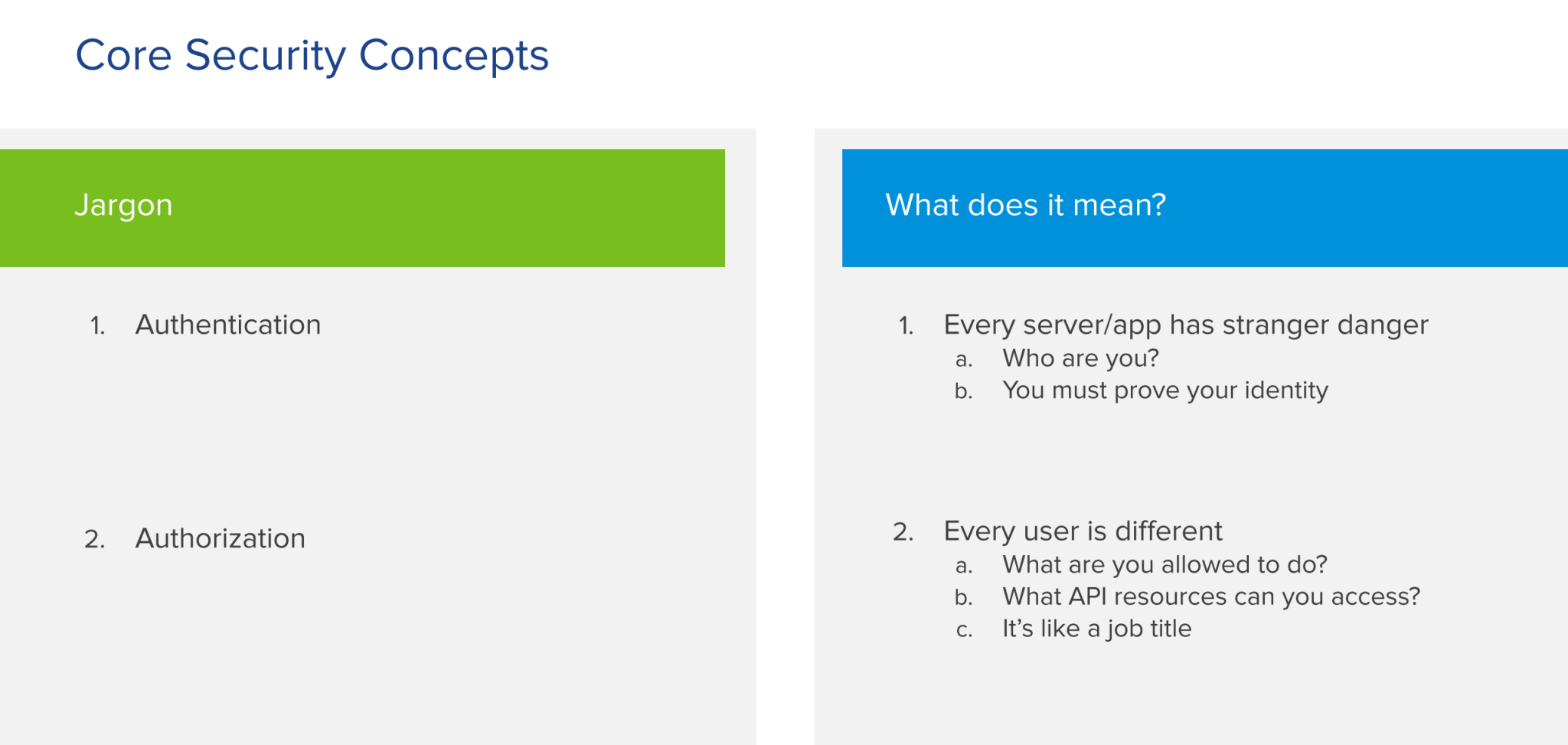
OAuth 2 Roles
To fully understand OAuth 2, you have to be aware of the following 4 actors that make up the specification:
- Resource Owner
- Resource Server
- Authorization Server
- Client / Application
As before, let’s explain it with a very basic example to see how it actually works.
Let’s say you have a jacket. Since you own that jacket, you are the Resource Owner and the jacket is the Resource you want to protect. You want to store the jacket in a locker to keep it safe. The locker will act as the Resource Server. You don’t own the Resource Server but it’s holding on to your things for you. Since you want to keep the jacket safe from being stolen by someone else, you have to put a lock on the locker. That lock will be the Authorization Server. It handles the security aspects and makes sure that only you are able to access the jacket or potentially someone else that you give permission. If you want your friend to retrieve your jacket out of the locker, that friend can be seen as the Client or Application actor in the OAuth flow. The Client is always acting on the user’s behalf.
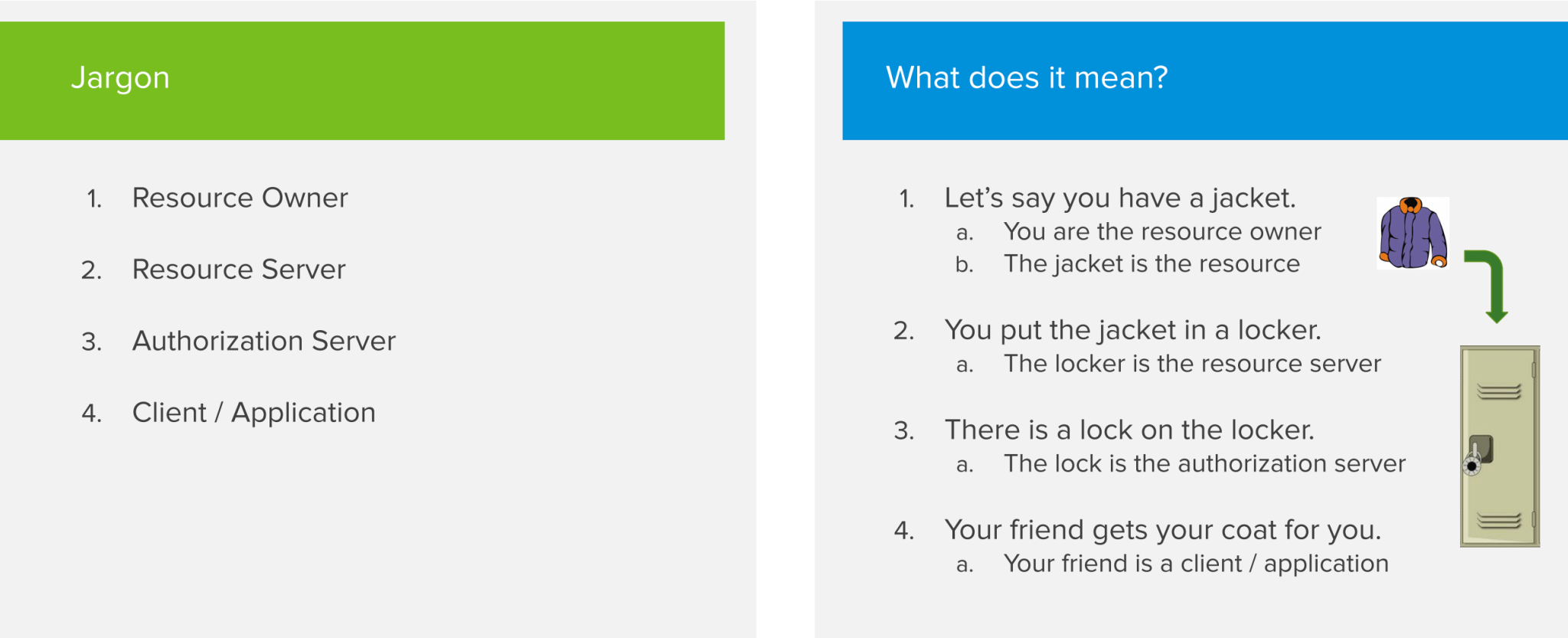
Tokens
The next concept that you’re going to hear about a lot is tokens.There are various types of tokens, but all of them are very straightforward to understand. The 2 types of tokens that you encounter the most are access tokens and refresh tokens.
When it comes to access tokens you might have heard about JWT tokens, bearer tokens or opaque tokens. Those are really just implementation details that I’m not going to cover in this article.
In essence, an access token is something you provide to the resource server in order to get access to the items it is holding for you. For example, you can see access tokens as paper tickets you buy at the carnival. When you want to get on a ride, you present your ticket to the person in the booth and they’ll let you on. You enjoy your ride and afterwards your ticket expires. Important to note is that whoever has the token, owns the token. So be very careful with them. If someone else gets a hold on your token, he or she can access your items on your behalf!
Refresh tokens are very similar to access tokens. Essentially, you use them to get more access tokens. While access tokens are typically short lived, refresh tokens tend to have a longer expiry date. To go back to our carnival example, a refresh token could be your parents credit card that can be used to buy more carnival tickets for you to spend on rides.
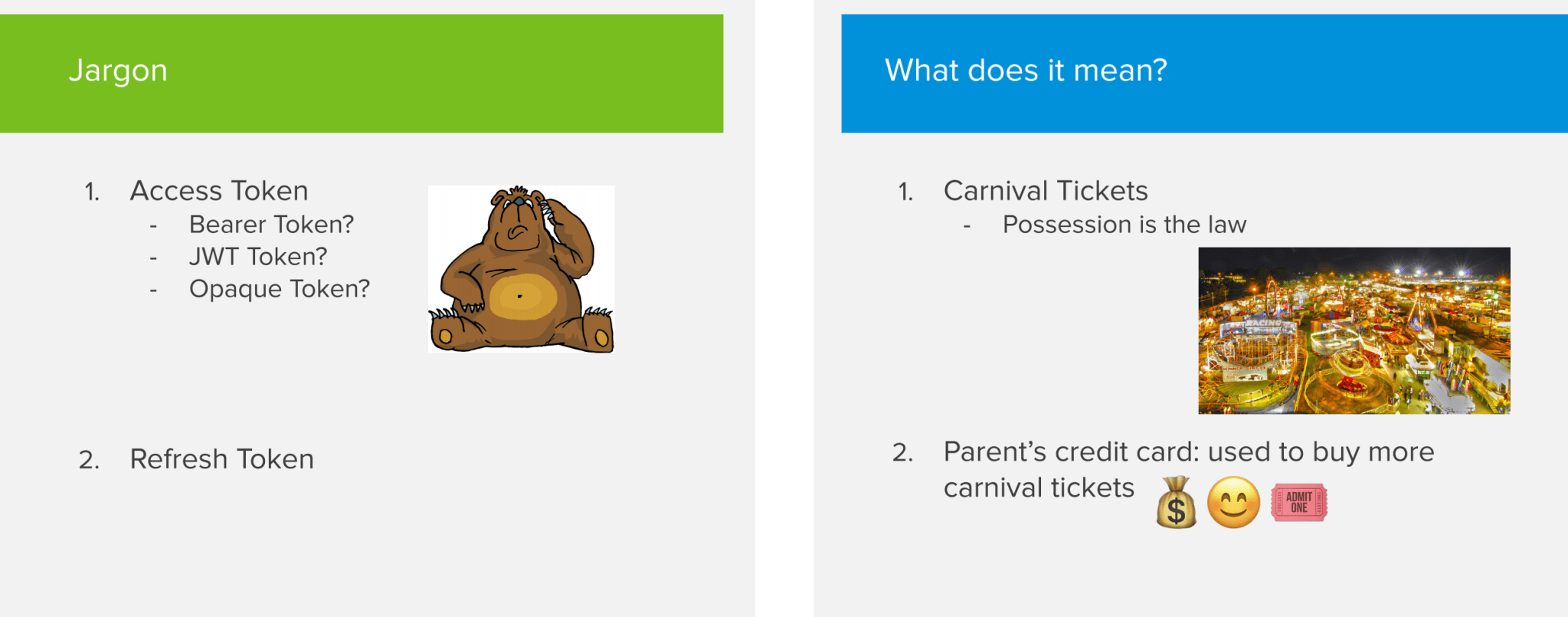
Scopes
The next concept to cover are scopes. A scope is basically a description of things that a person can do in an application. You can see it as a job role in real life (e.g a principal or teacher in a high school). Certain scopes can grant you more permissions than others.
I know I said I wasn’t going to get into technical details, but if you’re familiar with Spring Security, then you can compare scopes with what Spring Security calls roles. A scope matches one-on-one with the concept of a role.
The OAuth specification does not specify how a scope should look like but often they are dot separated Strings like blog.write. Google on the other hand uses URLs as a scope. As an example: to allow read only access to someone’s calendar, they will provide the scope https://www.googleapis.com/auth/calendar.readonly.
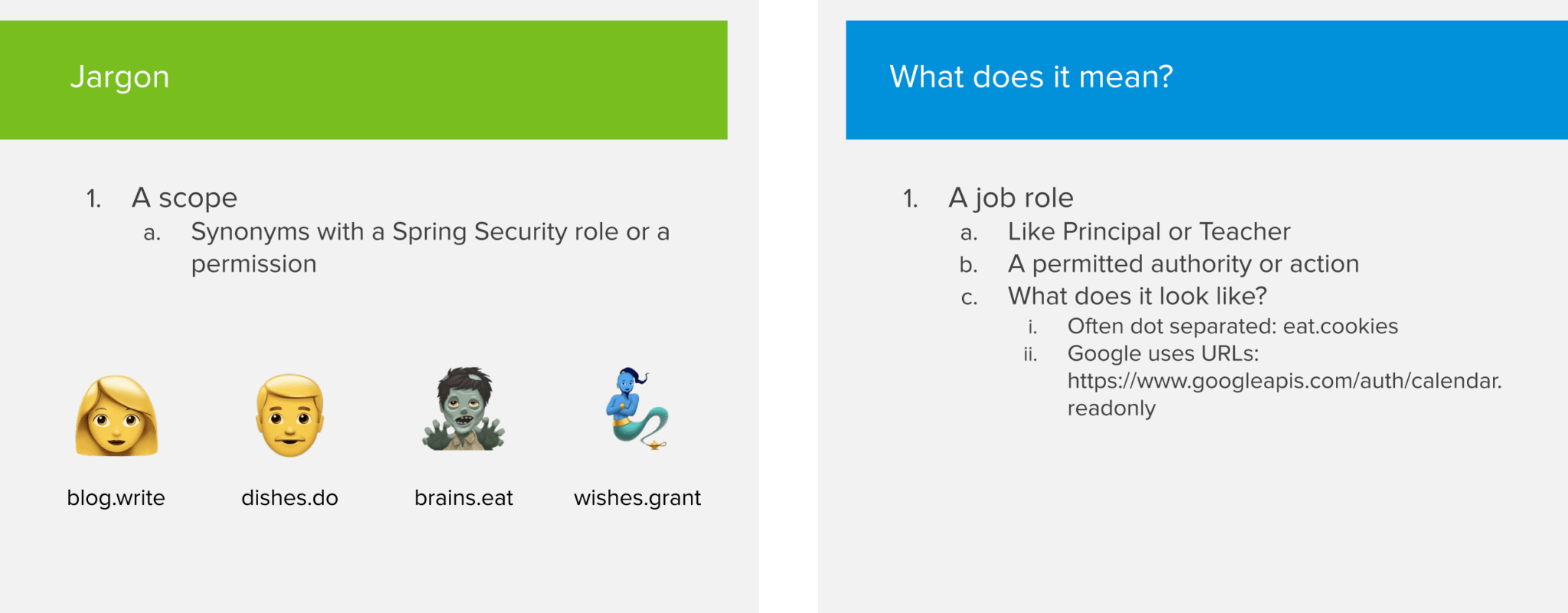
Grant types
Grant types are typically where things start to get confusing for people. Let’s first start with showing the most common used grant types:
- Client Credentials
- Authorization Code
- Device Code
- Refresh
- Password & Implicit
Client Credentials is a grant type used very frequently when 2 back-end services need to communicate with each other in a secure way.
The next one is the Authorization Code grant type, which is probably the most difficult grant type to fully grap. You use this grant type whenever you want users to login via a browser based login form. If you have ever used the ‘Log in with Facebook’ or ‘Log in with Google’ button on a website, then you’ve already experienced an Authorization Code flow without even knowing it!
Next up is the Device Code grant type, which is fairly new in the OAuth 2 scene. It’s typically used on devices that have limited input capabilities, like a TV. For example, if you want to log in to Netflix, instead of providing your username and password; it will pop-up a link that displays a code, which you have to fill in using the mobile app.
The Refresh grant type most often goes hand in hand with the Authorization Code flow. Since access tokens are short lived, you don’t want your users to be bothered with logging in each time the access token expires. So there’s this refresh flow that utilizes refresh tokens to acquire new access tokens whenever they’re about to expire.
The last 2 grant types are Password and Implicit. These grant types are less secure options that are not recommended when building new applications. We’ll touch on them briefly in the next section, which explains the above grant types in more detail.
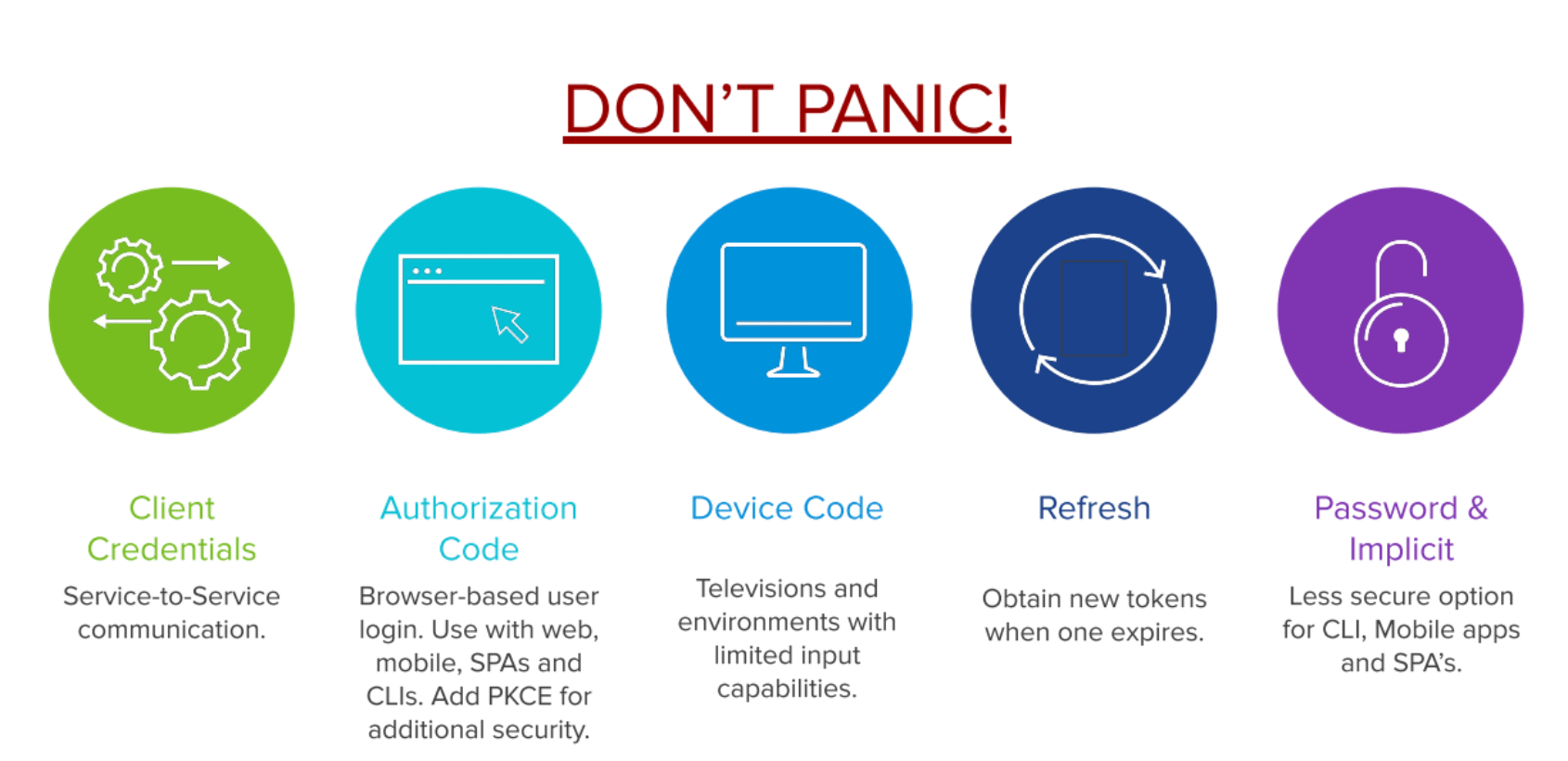
Authorization flows
An authorization flow contains one or more steps that have to be executed in order for a user to get authorized by the system. There are 4 authorization flows we’ll discuss:
- Client Credentials flow
- Password flow
- Authorization Code flow
- Implicit flow
Client Credentials flow
The Client Credentials flow is the simplest flow to implement. It works very similar to how a traditional username/password login works. Use this flow only if you can trust the client/application, as the client credentials are stored within the application. Don’t use this for single page apps (SPAs) or mobile apps, as malicious users can deconstruct the app to get ahold of the credentials and use them to get access to secured resources. In most use cases, this flow is used to communicate securely between 2 back-end systems.
So how does the Client Credentials flow work? Each application has a client ID and secret that are registered on the authorization server. It presents those to the authorization server to get an access token and uses it to get the secure resource from the resource server. If at some point the access token expires, the same process repeats itself to get a new token.
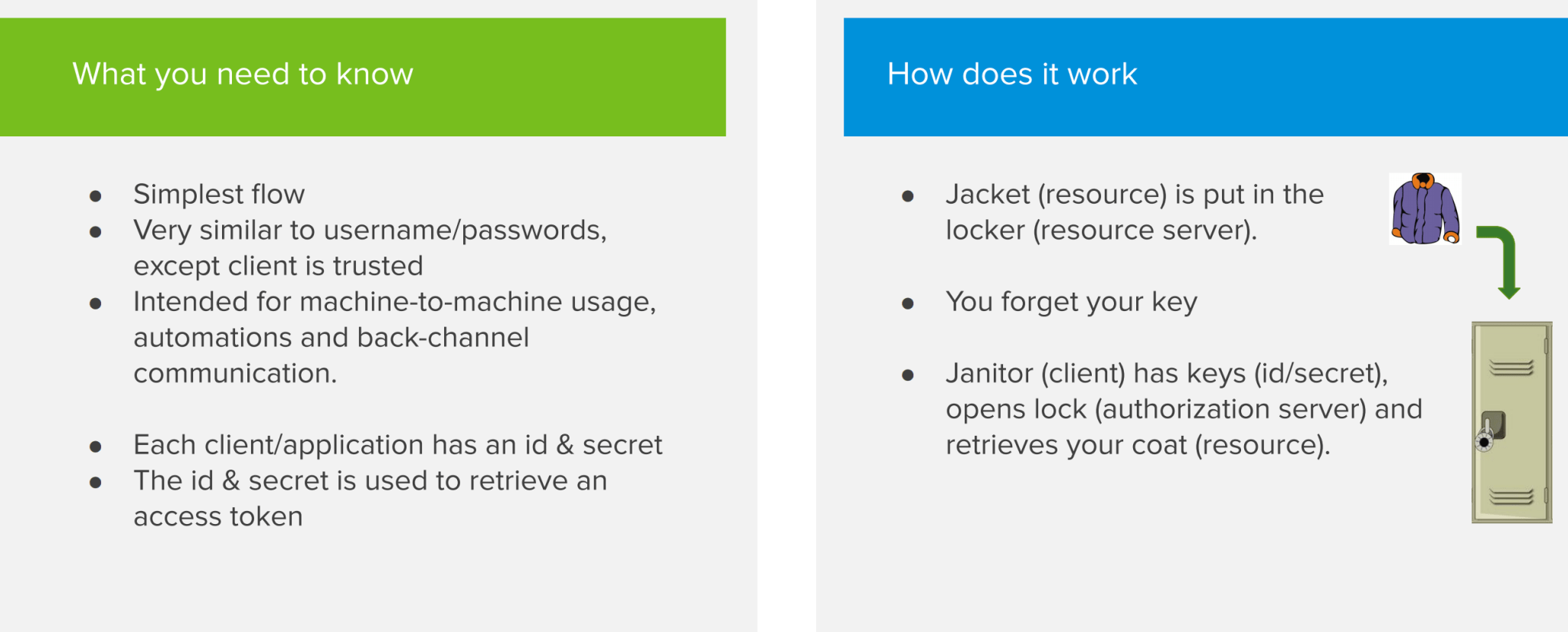
Password flow
The Password flow is very similar to the Client Credentials flow, but is very insecure because there’s a 3rd actor involved being an actual end user. Instead of a secure client that we trust presenting an ID and secret to the authorization provider, we now have a user ‘talking’ to a client. In a Password flow, the user provides their personal credentials to the client. The client then uses these credentials to get access tokens from the authorization server. This is the reason why a Password flow is not secure, as we must absolutely be sure that we can trust the client to not abuse the credentials for malicious reasons.
Exceptions where this flow could still be used are command line applications or corporate websites where the end user has to trust the client apps that they use on a daily basis. But apart from this, it’s not recommended to implement this flow.
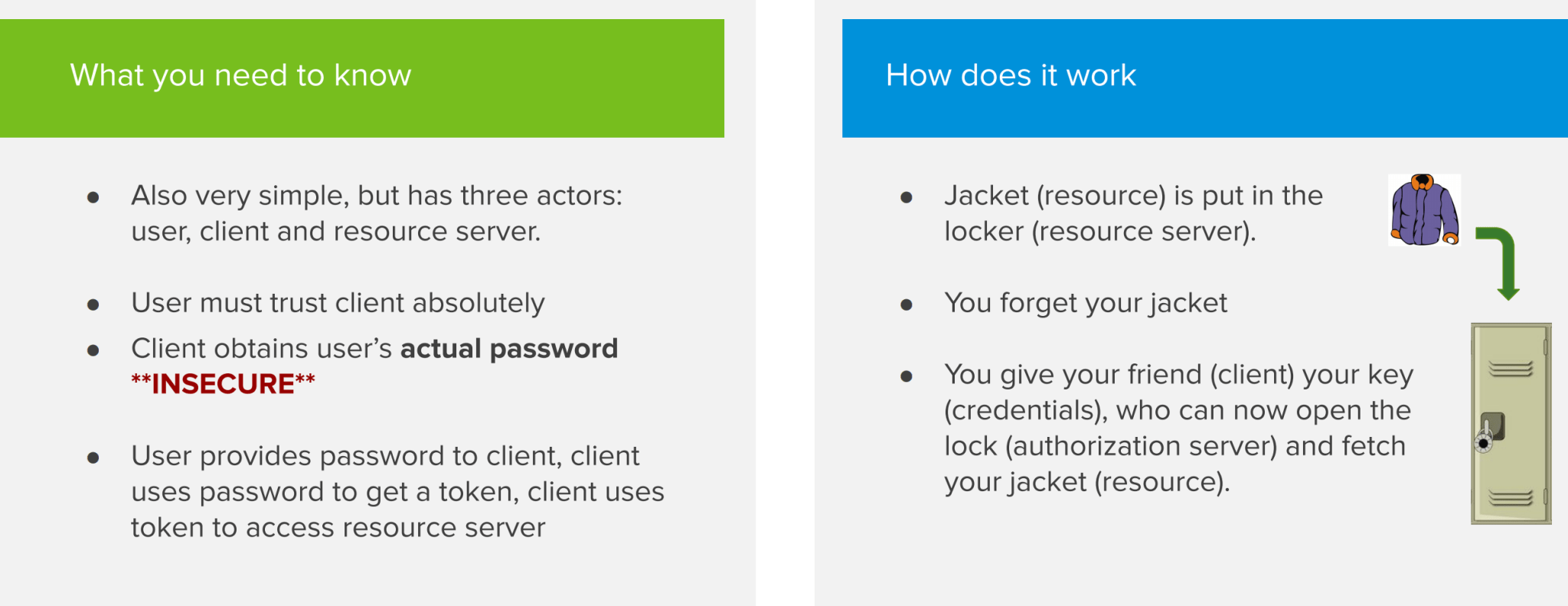
Authorization Code Flow
This is the flow that you definitely want to understand, as it’s the flow that’s used the most when securing applications with OAuth 2. This flow is a bit more complicated than the previously discussed flows. It’s important to understand that this flow is confidential, secure and browser based.
The flow works by making a lot of HTTP redirects, which is why a browser is an important actor in this flow. There’s also a back-channel request (called like this because the user is not involved in this part of the flow) in which the client or application talks directly to the authorization server. In this flow, the user typically has to approve the scopes or permissions that will be granted to the application. An example could be a 3rd party application that asks if it’s allowed to have access to your Facebook profile picture after logging in with the ‘Log in with Facebook’ button.
Let’s apply the Authorization Code flow to our ‘jacket in the closet’ example to get a better understanding.
Our jacket is in the locker and we want to lend it to a friend. Our friend goes to the (high-tech) locker. The locker calls us, as we are the Resource Owner. This call is one of those redirects we talked about earlier. At this point, we establish a secure connection to the locker, which acts as an authorization server. We can now safely provide our credentials to give permission to unlock the lock. The authorization server then provides a temporary code called OAuth code to our friend. The friend then uses that OAuth code to obtain an access code to open the locker and get my jacket.
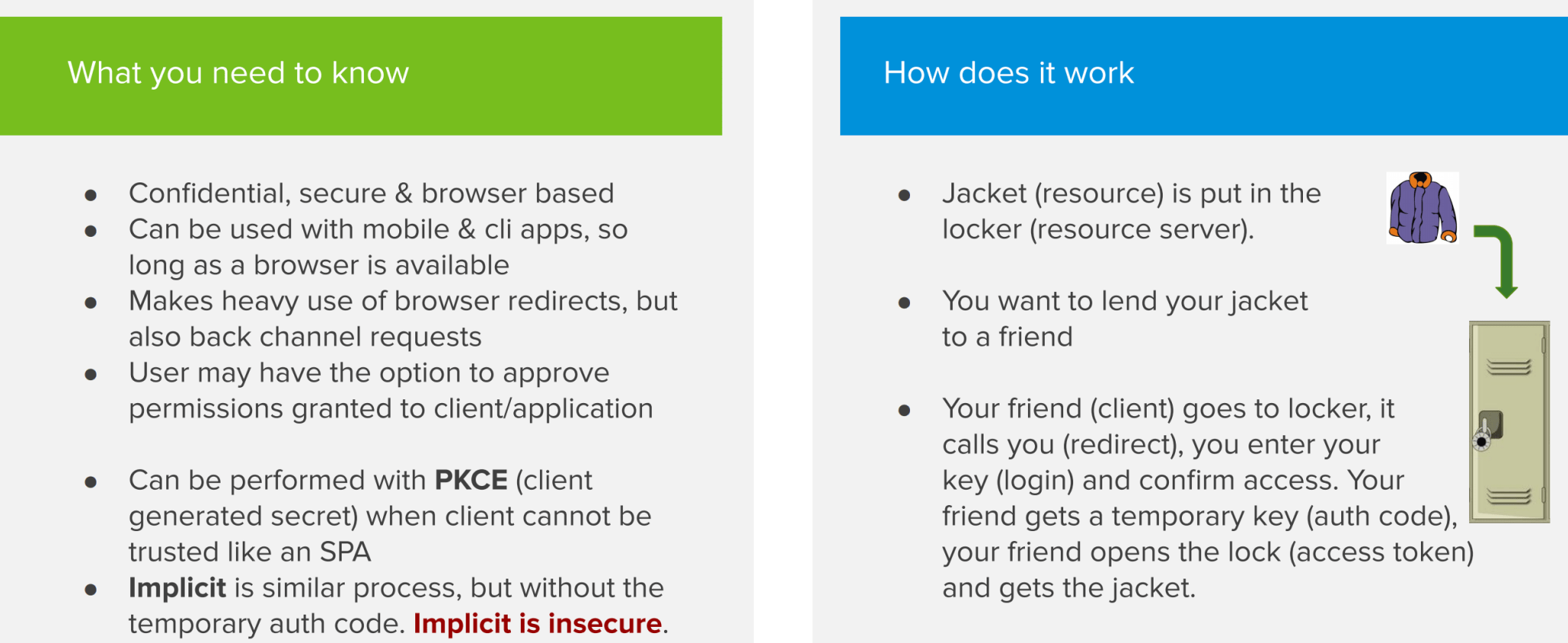
Implicit flow
The Implicit flow is basically the same as the Authorization Code flow, but without the temporary OAuth code. So after logging in, the authorization server will immediately send back an access token without requiring a back-channel request. This is less secure, as the token could be intercepted via a man-in-the-middle attack.
Conclusion
OAuth 2 may look daunting at first because of all the different actors involved. Hopefully, you now have a better understanding of how they interact with each other. With this knowledge in mind, it will be much easier to grasp the technical details once you start delving into them.

What others have also read


In software development, assumptions can have a serious impact and we should always be on the look-out. In this blog post, we talk about how to deal with assumptions when developing software. Imagine…you’ve been driving to a certain place A place you have been driving to every day for the last 5 years, taking the same route, passing the same abandoned street, where you’ve never seen another car. Gradually you start feeling familiar with this route and you assume that as always you will be the only car on this road. But then at a given moment in time, a car pops up right in front of you… there had been a side street all this time, but you had never noticed it, or maybe forgot all about it. You hit the brakes and fortunately come to a stop just in time. Assumption nearly killed you. Fortunately in our job, the assumptions we make are never as hazardous to our lives as the assumptions we make in traffic. Nevertheless, assumptions can have a serious impact and we should always be on the look-out. Imagine… you create websites Your latest client is looking for a new site for his retirement home because his current site is outdated and not that fancy. So you build a Fancy new website based on the assumption that Fancy means : modern design, social features, dynamic content. The site is not the success he had anticipated … strange … you have build exactly what your client wants. But did you build what the visitors of the site want? The average user is between 50 – 65 years old, looking for a new home for their mom and dad. They are not digital natives and may not feel at home surfing on a fancy, dynamic website filled with twitter feeds and social buttons. All they want is to have a good impression of the retirement home and to get reassurance of the fact that they will take good care of their parents. The more experienced you’ll get, the harder you will have to watch out not to make assumptions and to double-check with your client AND the target audience . Another well known peril of experience is “ the curse of knowledge “. Although it sounds like the next Pirates of the Caribbean sequel, the curse of knowledge is a cognitive bias that overpowers almost everyone with expert knowledge in a specific sector. It means better-informed parties find it extremely difficult to think about problems from the perspective of lesser-informed parties. You might wonder why economists don’t always succeed in making the correct stock-exchange predictions. Everyone with some cash to spare can buy shares. You don’t need to be an expert or even understand about economics. And that’s the major reason why economists are often wrong. Because they have expert knowledge, they can’t see past this expertise and have trouble imagining how lesser informed people will react to changes in the market. The same goes for IT. That’s why we always have to keep an eye out, we don’t stop putting ourselves in the shoes of our clients. Gaining insight in their experience and point of view is key in creating the perfect solution for the end user. So how do we tackle assumptions …? I would like to say “Simple” and give you a wonderful oneliner … but as usual … simple is never the correct answer. To manage the urge to switch to auto-pilot and let the Curse of Knowledge kick in, we’ve developed a methodology based on several Agile principles which forces us to involve our end user in every phase of the project, starting when our clients are thinking about a project, but haven’t defined the solution yet. And ending … well actually never. The end user will gain new insights, working with your solution, which may lead to new improvements. In the waterfall methodology at the start of a project an analysis is made upfront by a business analist. Sometimes the user is involved of this upfront analysis, but this is not always the case. Then a conclave of developers create something in solitude and after the white smoke … user acceptance testing (UAT) starts. It must be painful for them to realise after these tests that the product they carefully crafted isn’t the solution the users expected it to be. It’s too late to make vigorous changes without needing much more time and budget. An Agile project methodology will take you a long way. By releasing testable versions every 2 to 3 weeks, users can gradually test functionality and give their feedback during development of the project. This approach will incorporate the user’s insights, gained throughout the project and will guarantee a better match between the needs of the user and the solution you create for their needs. Agile practitioners are advocating ‘continuous deployment’; a practice where newly developed features will be deployed immediately to a production environment instead of in batches every 2 to 3 weeks. This enables us to validate the system (and in essence its assumptions) in the wild, gain valuable feedback from real users, and run targeted experiments to validate which approach works best. Combining our methodology with constant user involvement will make sure you eliminate the worst assumption in IT: we know how the employees do their job and what they need … the peril of experience! Do we always eliminate assumptions? Let me make it a little more complicated: Again… imagine: you’ve been going to the same supermarket for the last 10 years, it’s pretty safe to assume that the cereal is still in the same aisle, even on the same shelf as yesterday. If you would stop assuming where the cereal is … this means you would lose a huge amount of time, browsing through the whole store. Not just once, but over and over again. The same goes for our job. If we would do our job without relying on our experience, we would not be able to make estimations about budget and time. Every estimation is based upon assumptions. The more experienced you are, the more accurate these assumptions will become. But do they lead to good and reliable estimations? Not necessarily… Back to my driving metaphor … We take the same road to work every day. Based upon experience I can estimate it will take me 30 minutes to drive to work. But what if they’ve announced traffic jams on the radio and I haven’t heard the announcement… my estimation will not have been correct. At ACA Group, we use a set of key practices while estimating. First of all, it is a team sport. We never make estimations on our own, and although estimating is serious business, we do it while playing a game: Planning poker. Let me enlighten you; planning poker is based upon the principle that we are better at estimating in group. So we read the story (chunk of functionality) out loud, everybody takes a card (which represent an indication of complexity) and puts them face down on the table. When everybody has chosen a card, they are all flipped at once. If there are different number shown, a discussion starts on the why and how. Assumptions, that form the basis for one’s estimate surface and are discussed and validated. Another estimation round follows, and the process continues till consensus is reached. The end result; a better estimate and a thorough understanding of the assumptions surrounding the estimate. These explicit assumptions are there to be validated by our stakeholders; a great first tool to validate our understanding of the scope.So do we always eliminate assumptions? Well, that would be almost impossible, but making assumptions explicit eliminates a lot of waste. Want to know more about this Agile Estimation? Check out this book by Mike Cohn . Hey! This is a contradiction… So what about these assumptions? Should we try to avoid them? Or should we rely on them? If you assume you know everything … you will never again experience astonishment. As Aristotle already said : “It was their wonder, astonishment, that first led men to philosophize”. Well, a process that validates the assumptions made through well conducted experiments and rapid feedback has proven to yield great results. So in essence, managing your assumptions well, will produce wonderful things. Be aware though that the Curse of Knowledge is lurking around the corner waiting for an unguarded moment to take over. Interested in joining our team? Interested in meeting one of our team members? Interested in joining our team? We are always looking for new motivated professionals to join the ACA team! {% module_block module "widget_3ad3ade5-e860-4db4-8d00-d7df4f7343a4" %}{% module_attribute "buttons" is_json="true" %}{% raw %}[{"appearance":{"link_color":"light","primary_color":"primary","secondary_color":"primary","tertiary_color":"light","tertiary_icon_accent_color":"dark","tertiary_text_color":"dark","variant":"primary"},"content":{"arrow":"right","icon":{"alt":null,"height":null,"loading":"disabled","size_type":null,"src":"","width":null},"tertiary_icon":{"alt":null,"height":null,"loading":"disabled","size_type":null,"src":"","width":null},"text":"View career opportunities"},"target":{"link":{"no_follow":false,"open_in_new_tab":false,"rel":"","sponsored":false,"url":{"content_id":229022099665,"href":"https://25145356.hs-sites-eu1.com/en/jobs","href_with_scheme":null,"type":"CONTENT"},"user_generated_content":false}},"type":"normal"}]{% endraw %}{% end_module_attribute %}{% module_attribute "child_css" is_json="true" %}{% raw %}{}{% endraw %}{% end_module_attribute %}{% module_attribute "css" is_json="true" %}{% raw %}{}{% endraw %}{% end_module_attribute %}{% module_attribute "definition_id" is_json="true" %}{% raw %}null{% endraw %}{% end_module_attribute %}{% module_attribute "field_types" is_json="true" %}{% raw %}{"buttons":"group","styles":"group"}{% endraw %}{% end_module_attribute %}{% module_attribute "isJsModule" is_json="true" %}{% raw %}true{% endraw %}{% end_module_attribute %}{% module_attribute "label" is_json="true" %}{% raw %}null{% endraw %}{% end_module_attribute %}{% module_attribute "module_id" is_json="true" %}{% raw %}201493994716{% endraw %}{% end_module_attribute %}{% module_attribute "path" is_json="true" %}{% raw %}"@projects/aca-group-project/aca-group-app/components/modules/ButtonGroup"{% endraw %}{% end_module_attribute %}{% module_attribute "schema_version" is_json="true" %}{% raw %}2{% endraw %}{% end_module_attribute %}{% module_attribute "smart_objects" is_json="true" %}{% raw %}null{% endraw %}{% end_module_attribute %}{% module_attribute "smart_type" is_json="true" %}{% raw %}"NOT_SMART"{% endraw %}{% end_module_attribute %}{% module_attribute "tag" is_json="true" %}{% raw %}"module"{% endraw %}{% end_module_attribute %}{% module_attribute "type" is_json="true" %}{% raw %}"module"{% endraw %}{% end_module_attribute %}{% module_attribute "wrap_field_tag" is_json="true" %}{% raw %}"div"{% endraw %}{% end_module_attribute %}{% end_module_block %}
Read more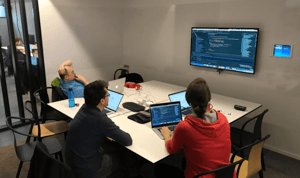
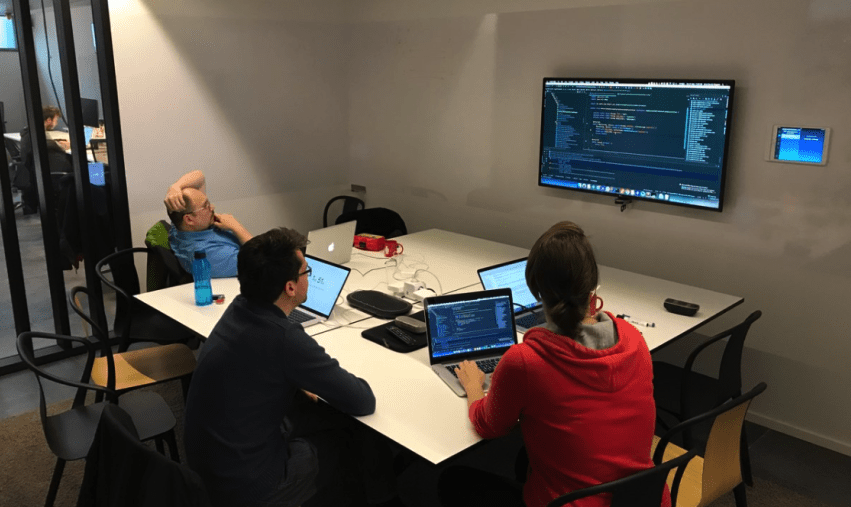
ACA does a lot of projects. In the last quarter of 2017, we did a rather small project for a customer in the financial industry. The deadline for the project was at the end of November and our customer was getting anxious near the end of September. We were confident we could pull off the job on time though and decided to try out an experiment. We got the team together in one room and started mob programming . Mob what? We had read an article that explains the concept of mob programming. In short, mob programming means that the entire team sits together in one room and works on one user story at a time. One person is the ‘driver’ and does the coding for a set amount of time. When that time has passed, the keyboard switches to another team member. We tried the experiment with the following set-up: Our team was relatively small and only had 4 team members. Since the project we were working on was relatively small, we could only assing 4 people. The user stories handled were only a part of the project. Because this was en experiment, we did not want the project - as small as it was - to be mobbed completely. Hence, we chose one specific epic and implemented those user stories in the mob. We did not work on the same computer. We each had a separate laptop and checked in our code to a central versioning system instead of switching the keyboard. This wasn't really a choice we made, just something that happened. We switched every 20 minutes. The article we referred to talks about 12, but we thought that would be too short and decided to go with 20 minutes instead. Ready, set, go! We spent more than a week inside a meeting room where we could, in turn, connect our laptops to one big screen. The first day of the experiment, we designed. We stood at the whiteboard for hours deciding on the architecture of the component we were going to build. On the same day, our mob started implementing the first story. We really took off! We flew through the user story, calling out to our customer proxy when some requirements were not clear. Near the end of the day, we were exhausted. Our experiment had only just started and it was already so intense. The next days, we continued implementing the user stories. In less than a week, we had working software that we could show to our customer. While it wasn’t perfect yet and didn’t cover all requirements, our software was able to conduct a full, happy path flow after merely 3 days. Two days later, we implemented enhancements and exception cases discussed through other user stories. Only one week had passed since our customer started getting anxious and we had implemented so much we could show him already. Finishing touches Near the end of the project, we only needed to take care of some technicalities. One of those was making our newly-built software environment agnostic. If we would have finished this user story with pair programming, one pair would know all the technical details of the software. With mob programming, we did not need to showcase it to the rest of the team. The team already knew. Because we switched laptops instead of keyboards, everyone had done the setup on their own machine. Everyone knew the commands and the configuration. It was knowledge sharing at its best! Other technicalities included configuring our software correctly. This proved to be a boring task for most of the navigators. At this point, we decided the mob experiment had gone far enough. We felt that we were not supposed to do tasks like these with 4 people at the same time. At least, that’s our opinion. Right before the mob disbanded, we planned an evaluation meeting. We were excited and wanted to do this again, maybe even at a bigger scale. Our experience with mob programming The outcome of our experiment was very positive. We experienced knowledge sharing at different levels. Everyone involved knew the complete functionality of the application and we all knew the details of the implementation. We were able to quickly integrate a new team member when necessary, while still working at a steady velocity. We already mentioned that we were very excited before, during and after the experiment. This had a positive impact on our team spirit. We were all more engaged to fulfill the project. The downside was that we experienced mob programming as more exhausting. We felt worn out after a day of being together, albeit in a good way! Next steps Other colleagues noticed us in our meeting room programming on one big screen. Conversations about the experiment started. Our excitement was contagious: people were immediately interested. We started talking about doing more experiments. Maybe we could do mob programming in different teams on different projects. And so it begins… Have you ever tried mob programming? Or are you eager to try? Let’s exchange tips or tricks! We’ll be happy to hear from you!
Read more

OutSystems: a catalyst for business innovation In today's fast-paced business landscape, organisations must embrace innovative solutions to stay ahead. There are a lot of strategic technological trends that address crucial business priorities such as digital immunity, composability, AI, platform engineering, Low-Code , and sustainability. OutSystems , the leading Low-Code development platform , has become a game-changer in supporting organisations to implement these trends efficiently and sustainably. OutSystems enhances cyber security As organisations increasingly rely on digital systems, cyber threats pose a significant risk. Additionally, digital engagement with customers, employees, and partners, plays a vital role in a company's well-being. The immunity and resilience of an organisation is now as strong and stable as its core digital systems. Any unavailability can result in a poor user experience, revenue loss, safety issues, and more. OutSystems provides a robust and secure platform that helps build digital immune systems , safeguarding against evolving cybersecurity challenges. With advanced threat detection, continuous monitoring, secure coding practices , and AI code-scanning, OutSystems ensures applications are resilient and protected. Furthermore, the platform covers most of the security aspects for project teams, enabling them to focus on delivering high value to end customers while best practices are recommended by the platform through code analysis using built-in patterns. OutSystems simplifies cloud-native infrastructure management Cloud-native architecture has emerged as a vital component for modern application development. The OutSystems Developer Cloud Platform enables teams to easily create and deploy cloud-native applications, leveraging the scalability and flexibility of cloud infrastructure through Kubernetes . It allows companies to: Optimise resource utilisation Auto-scale application runtimes Reduce operational costs Adopt sustainable practices (serverless computing, auto-scaling, …) All this without the need for prior infrastructure investment nor the deep technical knowledge required to operate it and the typical burdens associated. OutSystems: gateway to AI and automation AI and hyper-automation have become essential business tools for assisting in content creation, virtual assistants, faster coding, document analysis, and more. OutSystems empowers professional developers to be more productive by infusing AI throughout the application lifecycle. Developers benefit from AI-assisted development, natural language queries, and even Generative AI. Once ready with your development, transporting an app to the test or production environment only takes a few clicks. The platform highly automates the process and even performs all the necessary validations and dependency checks to ensure unbreakable deployments. OutSystems seamlessly integrates with AI capabilities from major cloud providers like Amazon, Azure (OpenAI), and Google, allowing project teams to leverage generative AI, machine learning, natural language processing , and computer vision . By making cutting-edge technologies more accessible, OutSystems accelerates digital transformation and creates sustainable competitive advantages. OutSystems enables composable architecture for agility Composable architecture and business apps, characterised by modular components, enable rapid adaptation to changing business needs. OutSystems embraces this trend by providing a cloud-native Low-Code platform using and supporting this type of architecture. It enables teams to easily build composable technical and business components. With the visual modelling approach of Low-Code, a vast library of customizable pre-built components and a micro-service-based application delivery model, OutSystems promotes high reusability and flexibility. This composable approach empowers organisations to: Respond rapidly to changing business needs Experiment with new ideas Create sustainable, scalable, and resilient solutions OutSystems enables the creation of business apps that can be easily integrated, replaced, or extended, supporting companies on their journey towards composability and agility. OutSystems facilitates self-service and close collaboration Platform engineering, which emphasises collaboration between development and operations teams, drives efficiency and scalability. OutSystems provides a centralised Low-Code platform embracing this concept at its core by being continuously extended with new features, tools and accelerators. Furthermore the platform facilitates the entire application development lifecycle until operations . Including features like Version control Automated deployment Continuous integration and delivery (CI/CD) Logging Monitoring Empowering organisations to adopt agile DevOps practices. With OutSystems, cross-functional teams can collaborate seamlessly, enabling faster time-to-market and improved software quality. By supporting platform engineering principles, OutSystems helps organisations achieve sustainable software delivery and operational excellence. OutSystems drives sustainability in IT OutSystems leads the way in driving sustainability in IT through its green IT Low-Code application development platform and strategic initiatives. By enabling energy-efficient development, streamlining application lifecycle management, leveraging a cloud-native infrastructure , and promoting reusability , OutSystems sets an example for the industry. Organisations can develop paperless processes, automate tasks, modernise legacy systems, and simplify IT landscapes using OutSystems 3 to 4 times faster, reducing overall costs and ecological footprint. By embracing OutSystems, companies can align their IT operations with a greener future, contribute to sustainability, and build a more resilient planet. Wrapping it up In the era of digital transformation and sustainability, OutSystems is a powerful ally for organisations, delivering essential business innovations, such as … High-performance Low-Code development Cloud-native architecture AI and automation Robust security measures Collaborative DevOps practices Take the OutSystems journey to align with IT trends, deliver exceptional results, and contribute to a sustainable and resilient future. Eager to start with OutSystems? Let us help
Read moreWant to dive deeper into this topic?
Get in touch with our experts today. They are happy to help!

Want to dive deeper into this topic?
Get in touch with our experts today. They are happy to help!

Want to dive deeper into this topic?
Get in touch with our experts today. They are happy to help!

Want to dive deeper into this topic?
Get in touch with our experts today. They are happy to help!


